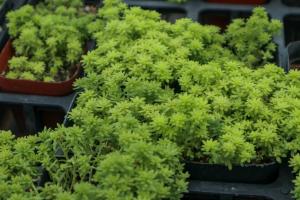Ramet propagation
Branching time: it is best to thaw the soil in early spring (February and March)
Plant separation method: after the mother plant is taken out from the flower pot, shake off the excess pot soil, separate the coiled root systems as far as possible, cut it into two or more plants with a sharp knife, each plant must have more root systems, and trim its leaves appropriately to reduce water transpiration, so as to facilitate survival
Potting disinfection: soak the divided small strains in 1500 times of chlorothalonil solution for five minutes, take them out and dry them, and then they can be put into the basin. You can also irrigate the root with chlorothalonil immediately after you put it in the basin

Management after plant separation: after plant separation and pot filling, root irrigation or one-time water infiltration shall be carried out. Because its roots are severely damaged and its water absorption ability is very weak, it takes about 3~4 weeks to restore the new roots. Therefore, adorable plants should be watered for 3~4 weeks after the ramets, so as to prevent root rot. However, its transpiration is not affected. To maintain the water balance of leaves, it needs to spray 1~3 times a day (high temperature, high temperature, low spray or no spray). Don't fertilize during this time. After branching, it should be noted that the sunlight should not be too strong, and it should be placed in the shade shed for maintenance as far as possible
Upper basin: when the seedlings are loaded into the basin, first put 2 ~ 3cm thick coarse-grained matrix or ceramsite into the basin bottom as the filter layer, sprinkle a layer of fully decomposed organic fertilizer on it as the base fertilizer, with a thickness of about 1 ~ 2cm, then cover a layer of matrix, with a thickness of about 1 ~ 2cm, and then put it into the plant to separate the fertilizer from the root system and avoid root burning
The substrate for the upper basin can choose one of the following. Vegetable garden soil: slag = 3:1; Or garden soil: medium coarse river sand: sawdust = 4:1:2; Or one of paddy soil, pond mud and rotten leaf soil. Or peat: Perlite: ceramsite = 2:2:1; Vegetable garden soil: slag = 3:1; Peat: slag: ceramsite = 2:2:1; Sawdust: vermiculite: medium coarse river sand = 2:2:1. After the basin is finished, pour water once and put it in a shady environment for maintenance
Tissue culture propagation
Petioles of tender stems or undeveloped leaves are often used as explants. After regular disinfection, the petiole was cut into 3mm segments and the young stem was cut into 3mm segmented segments under sterile conditions, and then inoculated on the culture medium to induce the formation of callus and adventitious buds. After culture, new plants were formed


 how many times do yo...
how many times do yo... how many planted tre...
how many planted tre... how many pine trees ...
how many pine trees ... how many pecan trees...
how many pecan trees... how many plants comp...
how many plants comp... how many plants can ...
how many plants can ... how many plants and ...
how many plants and ... how many pepper plan...
how many pepper plan...































